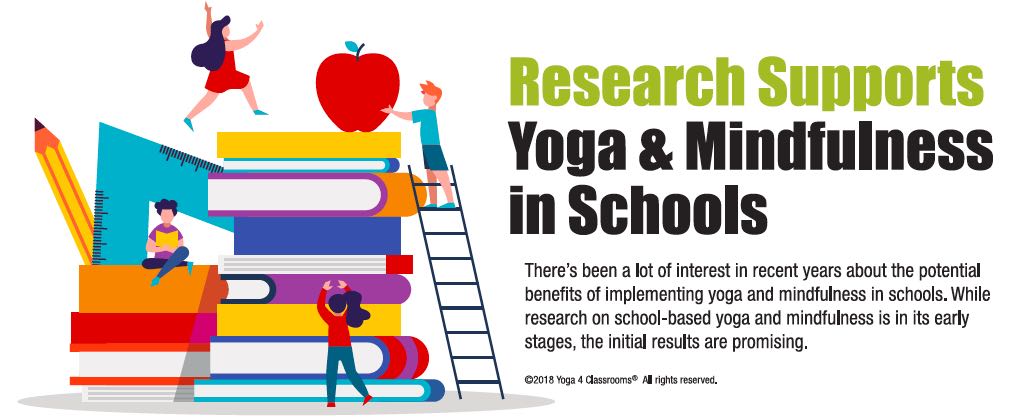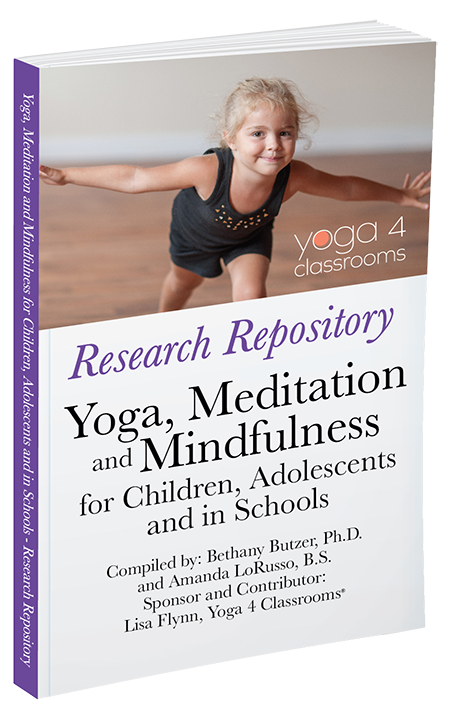|
Check out our brand new product-- Mini Yoga 4 Classrooms Activity Cards! For mindful moments on-the-go!
|
A growing body of scientific evidence suggests a multitude of benefits of yoga and mindfulness for children, adolescents, and in schools.
The following are just some of the many recognized benefits of yoga and mindfulness for children and youth.
Yoga helps children see the beauty and light within themselves, thereby boosting their self-confidence, allowing them to feel more comfortable with their bodies, and helping them get in touch with who they are inside. A child who learns yoga, mindfulness and relaxation will be developing essential skills for a lifetime of health and well-being of their whole selves.
There are 6 main benefit areas of yoga and mindfulness in schools: mental health and resilience, social-emotional skills, physical health, academic performance, classroom/school climate, and teacher well-being. Download the infographic! to learn more.

A growing number of research studies investigating school-based yoga and mindfulness implementation suggest beneficial effects on student health, behavior, and performance, teacher well-being, and classroom climate, among other potential benefits.
Increasing numbers of teachers and administrators are recognizing that yoga, breath awareness and mindfulness activities are beneficial to their students’ (and their own!) mental health and well-being, and to the learning environment in general. In addition, yoga and mindfulness practices promote self-awareness and self management skills, the basis of social and emotional learning (SEL) competencies as espoused by CASEL (Collaborative for Social and Emotional Learning). As yoga offers a non-competitive alternative to sports that supports PE and health standards, it’s also becoming part of many physical and health education curricula and after school enrichment offerings.
The many anecdotal benefits of yoga and mindfulness-based practices for children are well known, and carefully-controlled scientific research is growing exponentially. Based on increasing evidence supporting the efficacy of yoga for children, school-based yoga programs are being implemented across the United States. These programs are designed to address stress and anxiety, place emphasis on individual abilities rather than competition, and provide a non-threatening and gentle method to increase physical fitness and enhance health, well-being and emotional resilience.
With over 250 new peer-reviewed studies published each year, research in this field is still considered somewhat preliminary. However scientific studies suggest that children and youth who practice yoga-based movement, conscious breathing, and mindfulness/meditation activities are better able to regulate their emotions, manage stress and calm themselves. They may also choose better foods to eat and engage in more physical activity than children who do not (Butzer et al., 2016; Khalsa & Butzer, 2016). Studies also suggest that centered, calm and focused children learn more easily, have better social skills and, in general, are happier kids.
Studies also show that movement and exercise facilitate children’s executive function (i.e., processes required to select, organize, and properly initiate goal-directed actions) by increasing activation in the prefrontal cortex and serotonergic system. By integrating physical movement with breathing exercises and mindful awareness, yoga serves as a promising form of physical and cognitive training to enhance learning-related outcomes (Butzer et al., 2016).
In summary, research on school-based yoga and mindfulness suggests that implementation may have a number of positive effects on student health, behavior, and performance. (Butzer et al., 2016; Felver et al., 2015; Ferreira-Vorkapic et al., 2015; Khalsa & Butzer, 2016; Chung, 2018; Maynard et al., 2017; Serwacki & Cook-Cottone, 2012; Zenner et al, 2014). The following outline some of the benefits of school-based yoga and mindfulness practices that address the whole child, thus maximizing the development of academic, social and emotional competence in addition to benefits for teachers and classroom climate:
Enhances resilience and coping frequency, thereby helping students adapt and cope with negative life events (Khalsa et al., 2012; Felver et al., 2018; Ramadoss & Bose, 2010; White, 2012; Sarkissian et al., 2018).

We created the Research Repository: Yoga, Meditation and Mindfulness for Children, Adolescents and in Schools as a helpful tool for researchers, decision-makers, students, and others interested in the growing body of evidence supporting the field. Updated twice each year in July and January, this organized, categorized ebook includes over 1,500 peer-reviewed, published studies and research review articles with links to abstracts and full-text publications.
| Cookie | Duration | Description |
|---|---|---|
| cookielawinfo-checkbox-analytics | 11 months | This cookie is set by GDPR Cookie Consent plugin. The cookie is used to store the user consent for the cookies in the category "Analytics". |
| cookielawinfo-checkbox-functional | 11 months | The cookie is set by GDPR cookie consent to record the user consent for the cookies in the category "Functional". |
| cookielawinfo-checkbox-necessary | 11 months | This cookie is set by GDPR Cookie Consent plugin. The cookies is used to store the user consent for the cookies in the category "Necessary". |
| cookielawinfo-checkbox-others | 11 months | This cookie is set by GDPR Cookie Consent plugin. The cookie is used to store the user consent for the cookies in the category "Other. |
| cookielawinfo-checkbox-performance | 11 months | This cookie is set by GDPR Cookie Consent plugin. The cookie is used to store the user consent for the cookies in the category "Performance". |
| viewed_cookie_policy | 11 months | The cookie is set by the GDPR Cookie Consent plugin and is used to store whether or not user has consented to the use of cookies. It does not store any personal data. |